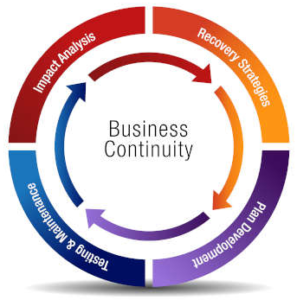A Business Continuity service refers to a set of strategies, processes, and technologies that aim to ensure the  continuous operation of critical IT systems and services during and after unexpected events or disasters. The goal is to minimize downtime, maintain data integrity, and enable the organization to continue its essential functions and services without significant interruptions. Business Continuity services are an essential part of an organization’s overall disaster recovery and risk management plan. Here are the key components of a Business Continuity service from an IT perspective, not all are required but they are recommended:
continuous operation of critical IT systems and services during and after unexpected events or disasters. The goal is to minimize downtime, maintain data integrity, and enable the organization to continue its essential functions and services without significant interruptions. Business Continuity services are an essential part of an organization’s overall disaster recovery and risk management plan. Here are the key components of a Business Continuity service from an IT perspective, not all are required but they are recommended:
- Risk Assessment and Business Impact Analysis: Identifying potential risks and assessing their impact on IT systems and services. This involves understanding the criticality of various applications and data, as well as evaluating vulnerabilities and threats.
- Business Continuity Planning: Developing a comprehensive plan that outlines how IT operations will continue functioning during a disaster or disruption. This plan includes detailed procedures for backup and recovery, failover, and restoring services.
- Data Backup and Replication: Implementing robust data backup and replication mechanisms to create redundant copies of critical data and ensure it can be quickly restored in the event of data loss or corruption.
- Redundant Infrastructure: Deploying redundant IT infrastructure, such as servers, storage, and networking equipment, to eliminate single points of failure and enhance system resilience.
- High Availability Solutions: Utilizing high availability technologies that automatically switch to redundant systems when a failure occurs, ensuring continuous access to critical applications and services.
- Disaster Recovery Sites: Establishing off-site disaster recovery locations where IT operations can be quickly moved in case the primary data center becomes unavailable.
- Testing and Exercises: Regularly testing the Business Continuity plan through simulation exercises and drills to identify weaknesses, validate recovery procedures, and train personnel.
- Incident Response and Crisis Management: Developing incident response plans to address immediate threats and crises effectively and efficiently, minimizing the impact on IT operations.
- Communication and Notification: Establishing communication channels to keep stakeholders informed during a crisis.
- Continuous Monitoring and Auditing: Implementing monitoring tools and processes to continuously assess the health and performance of IT systems. Conducting regular audits to ensure compliance with Business Continuity requirements and industry standards.
- Employee Training and Awareness: Educating employees about the Business Continuity plan, their roles during a crisis, and the importance of maintaining business continuity.
- Regular Updates and Improvements: Continuously reviewing and updating the Business Continuity plan to adapt to changing business needs, technological advancements, and emerging threats.
In summary, an IT Business Continuity service is a critical component of an organization’s disaster recovery and risk management strategy. It ensures that IT systems and services can withstand disruptions and continue operating with minimal downtime, safeguarding business operations.
